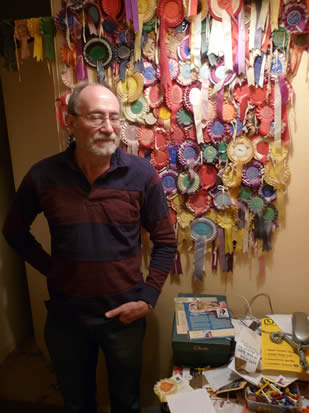 Martin Diggle joined the now-defunct Greater London Council’s
Supplies Department in 1971. He’d just left Sir Walter
St. John’s School in Battersea, at the time one of the
top Grammar Schools in London, but now also defunct. He says
he has that effect on institutions.
Martin Diggle joined the now-defunct Greater London Council’s
Supplies Department in 1971. He’d just left Sir Walter
St. John’s School in Battersea, at the time one of the
top Grammar Schools in London, but now also defunct. He says
he has that effect on institutions.
Always keen on sport, he cycled, swam, played football, cricket,
tennis and golf, but was about to add another major interest
to this repertoire. The GLC had a number of staff clubs and societies,
including a Riding Club, which was particularly engaged in encouraging
newcomers. Although they had never ridden, Martin’s parents
had always liked horses and there had been numerous annual trips
to a big horse show that used to take place on Clapham Common,
within walking distance of their Battersea home.
Martin says: “I remember always liking horses. As a kid
in those days, the rag and bone man would come down the street;
I would always run out and give the horse a carrot. But that
was all. There was no question of having a horse or anything
like that.”
Now, however, with an income to pay for lessons, he threw himself into
this new sport with great enthusiasm.
The GLC Staff Riding Club was, at the time, pretty much in its
infancy. Its main base was an old riding school in Upper Norwood,
within the London Borough of Lambeth (an area which produced
top dressage rider, Dane Rawlins). This school was also the main
base for the South London Saddle Club, and provided the horsepower
for club members and clients to participate in local shows held
on nearby parks and commons.
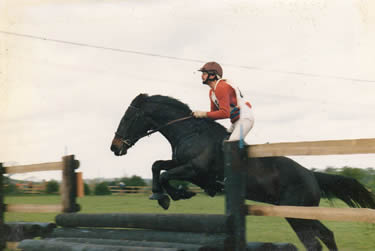 Martin says: “I remember hacking one of the school’s
horses through the streets of Norwood to compete in the local
Jumping class at the Lambeth Country Fair. We came third behind
two people riding eventers. I became friendly with these people
and later used to ride with them at their yard in Kent.”
Martin says: “I remember hacking one of the school’s
horses through the streets of Norwood to compete in the local
Jumping class at the Lambeth Country Fair. We came third behind
two people riding eventers. I became friendly with these people
and later used to ride with them at their yard in Kent.”
<< Ebony attacking the first fence
at a hunter trial with her usual gusto.
As experience increased, Martin made other significant contacts.
One influential figure was Terry Colgate, whose son and daughter
went on to have successful careers as professional riders. Based
in Surrey, and later in Hampshire, Terry gave Martin great support
and the opportunity to compete further at local level.
In 1978, Martin answered an advert in Horse and Hound from
a couple in Chislehurst who were looking for someone to compete
their Thoroughbred ex-hurdler, Willie Dwell, a grandson of the
Derby winner, Never Say Die. This led to a happy and successful
period showjumping, hunter trialling and eventing, until Willie’s
thin soles signaled semi-retirement.
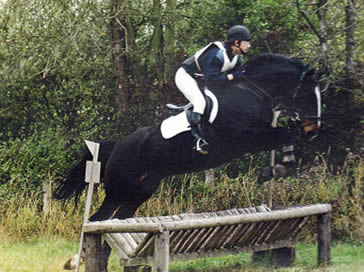
Still involved in the GLC Staff Riding Club (and for several
years its Secretary) Martin continued to take part in club activities,
went hunting in the West Country on occasion, and helped a friend
qualify his point-to-pointers. In company with a friend, he also
acquired a cob mare, Ebony who, in her previous riding school
ownership “had been famous for carting people over Epsom
Downs. She had the heart of an eventer. All she was interested
in was eating, jumping and galloping. She was a great local-level
competition horse but unfortunately developed navicular.”
A first outing
with Clifden. >>
Later, after a career change into publishing, Martin acquired
a TB/Irish cross, Clifden, “a real character with prehensile
lips and a penchant for blackberries”. Unfortunately, the
business Martin worked for hit financial problems, and
redundancy forced the sale of Clifden, to a good hunting home
in the Shires. It was in the aftermath of redundancy that he
began his current career as a freelance editor.
Martin’s connection with publishing had begun in the 1980s
when, initially with a view to helping Riding Club members, he
set about writing a pamphlet on jumping. This, entitled Riding
Over Jumps, was published by J.A. Allen, who went
on to commission further titles in the same series: Riding
Cross-country,
Riding a Dressage Test and Riding
From Scratch .Following
these titles, he wrote Teaching the
Mature Rider, Teaching
Basic Jumpingand compiled the Masters of Equitation series
of four books and The Allen Encyclopaedia
of Dressage. The
book that was most fun for him was Equitation– the
Truth (1993), a title produced together with the illustrator
Maggie Raynor, with whom he has shared Clifden. This, described
by the publisher as a “hilarious examination of the grass
roots of equitation” is a mixture of fundamentally true
anecdotes, comic verse and cartoons that deserves to be better
known in the horsey world.
Martin’s latest book, The Novice Rider’s Companion,
published by Kenilworth Press, is his thirteenth, and he is still
riding.
“I just like it,” he says. “I like horses. Riding is the
thing I enjoy most in life.”
Book Review
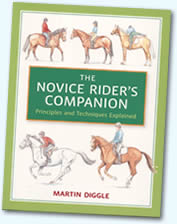
The Novice Rider’s Companion by
Martin Diggle
This book is a fantastic place to start if you are at the
early stages of persuing an equestrian career.
If your dream is to become the next top Olympic rider, or
to just be able to ride in the forest, this book will benefit
you greatly.
Martin’s book is clearly illustrated, very informative,
charmingly witty and clearly well written. Martin writes
in great detail of the things you may hear in your lessons,
but do not fully understand. Which I’m sure we can
all relate to at some point or another….
Martin explains to the reader what the sensation of riding
a horse for the first time will feel like and what to expect,
and the desire to cling on for dear life!
This book was a joy to read, and I wish this book was available
when I first started to ride, I feel it would have benefitted
me a lot!
I shall be recommending this to Novice riders of all ages,
who will learn much more with this insightful guide, helping
your theory of riding develop alongside your practical lessons.
Liz Kinnish
Of all the hundreds of horses, he has ridden over the years, showjumping,
eventing, hunting and even just hacking out (once when hacking
across Epsom Downs, he parked the mare he was riding against
the racecourse running rail and watched the Oaks from her back),
he has no problem recalling some favourites.
“The first was a funny little multi-coloured Cob, William, who was at
the West Norwood riding school. He was a real character who knew his job inside
out. I heard that he lived into his late thirties and was put down because
he’d gone blind.
“Willie, the eventer, was a bold and generous horse on whom I gained
some great experience. His owner, Elsie, was a truly great maker of cakes.
“Clifden and Ebony were both great fun and real mates, and my friend
Yvonne had a hackney mare, Holly, who was like a pterodactyl on speed – if
something really grabbed her attention she’d respond with a series of
courbettes.”
Try him on horsey books:
“Paul Belasik, Dressage for the 21st Century. It was published
in 2002. It’s the best modern book on dressage I’ve read. I also
admire Gustav Steinbrecht’s The Gymnasium of the Horse. First
published in 1885, it spans the transition between the old classical high school
and the development of outdoor equestrian sport.
“My father gave me a copy of Riding and Jumping by Bill Steinkraus
soon after I started riding and I still think it’s one of the best books
on showjumping.
“On the racing front, I enjoyed Peter O’Sullevan’s autobiography Calling
the Horses and, as a book on race-riding technique, I like John Hislop’s Steeplechasing.”
Asked what he thought of Jilly Cooper’s equestrian themed
books, his response was monosyllabic and dismissive.
Reason for Sale - Owner no Time
This poem was inspired by a lot of horse owners I know - not all of
them women:
So, I've finally mucked out and plaited
And given my horse a shampoo
Cleaned my tack, drunk some tea, had a fag and - let's see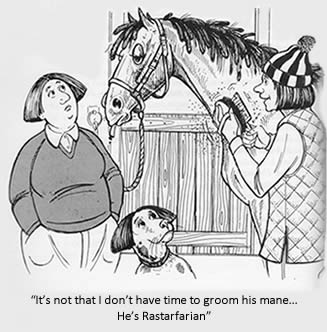
Spent at least half an hour in the loo.
And I've had a good gossip with Mandy
Well, Pam and that blacksmith of hers!
Mandy said for a fact they'd been caught in the act
And with Pam wearing nothing but spurs.
Now I've got to empty my barrow
And give the New Zealand a clean
And point out to Tony that his daughter's pony
Is looking a little bit lean
And I should try to sort out that poll guard
I think it should really go back
Though it fits him a treat and looks perfectly neat
I have never quite liked him in black.
And now to get into my jodhpurs
And take my horse out for a ride
I am sure, were he fit, we could win quite a bit
But I just don't have time on my side.
Gosh it's quarter to seven already
And I've said I'll go out with a friend
I've no time for a hack, I would never get back-
But I must try to ride this weekend.
So what about riders?
“I was a great fan of John Francome when he was race-riding, and there
are some really good jump jockeys around nowadays. From the eventing perspective,
I still reckon Mark Todd and Lucinda Green were as good as any. In UK showjumping,
Ben Maher seems to be doing very well. At the moment I’m out of love
with competition dressage – it’s in danger of becoming a freak
show, with some questionable practices and judging. That’s not to say
there aren’t some very talented riders out there, but some of the most
inspirational pictures are of riders such as Richard Wätjen, from the
middle of the last century.”
And the final question: what’s his next book going to be
about?
“We’ll see how the latest one goes, and perhaps do something similar
on the first steps in jumping, but I’d really like to revisit the ideas
in Equitation – the Truth.”
